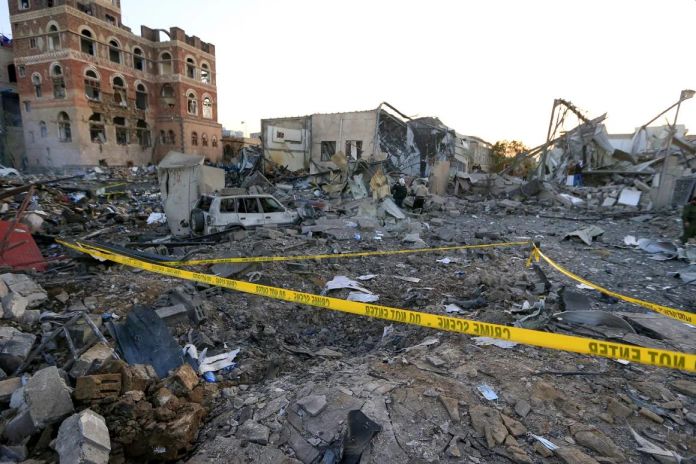By Eric Vandenbroeck and co-workers
Why Bombing the Houthis Won’t Work
The humiliating
gaffes of Signalgate are only one measure of the
Donald Trump team’s recklessness. The air war against Yemen’s Houthi rebels,
the subject of the texts, could end up becoming a scandal in its own right and
for similar reasons. It is a war with no apparent strategy apart from Trump’s
hunger for what he calls “swift and unrelenting action” on almost every
front. And it is likely to backfire badly if the administration doesn’t change
course.

The Signal discussion
didn’t touch on how the Yemen bombings would affect Washington’s current
diplomatic overture to Tehran. Hegseth and the President likely think it can’t
hurt: Tehran will see Trump’s Washington as tougher for it and capable of
coercing the Iranians into nuclear negotiations. The Vice President doesn’t
believe Washington should go to war with Tehran over the nuclear issue, let
alone Suez Canal traffic. If he isn’t willing to bomb an Iranian proxy for fear
of a slippery slope, then he is surely unlikely to want to bomb its sponsor.
Jeddhah Waterfront

How It All Began
The Houthis emerged
as a military force in 2004 in an uprising against the Yemen government.
Initially about 2,000 strong, they were equipped with little more than light
weapons and an unshakable belief in their cause. By 2009, the conflict had
escalated, and the government launched a massive offensive against the Houthis
called Operation Scorched Earth, backed with tanks and airpower.
In 2011, protests in
the capital, Sana’a, erupted into a full-scale revolution, and the Houthis joined the struggle for power in
what became a civil war. They seized Sana’a in early 2014 and started working
outwards. By this time, the Houthi force numbered more than 100,000 and had
evolved considerably.
When the Houthis took
over Sana'a in 2014, they systematically absorbed much of Yemen's armed forces
and their intelligence services. Many of the officers and enlisted men across
all branches were integrated into the Houthi organization.
Strikes have targeted
Sana’a, Yemen’s capital, as well as the port city of Hodeidah
and the Houthi stronghold of Sa’ada. The targets
include densely populated areas, but assessing the impact on civilians of the
strikes, which are coordinated with and supported by UK armed forces, is
difficult.
The Current Situation
A decade of violence
has shattered Yemen’s already weak economy and left millions of people unable
to find decent livelihoods to support their families. As a result, out of a
population of roughly 36 million, about 19
million people require aid, 15
million of whom are women and children. Half of all children under five in
Yemen are malnourished, according to Unicef. An aid
plan for 2025 is only 6.5% funded so far.
If the President
decides to attack the Islamic Republic’s ports and missile factories because of
its Yemeni machinations, then hitting the nuclear sites will surely follow. The
Trump administration’s intentions on a lot of issues are challenging to assess
since the President isn’t captured by consistency and humbled by contradiction.
But he does seem to understand that the nuclear issue cannot be separated from
the Islamic Republic’s proxy imperialism. They are solved together, or they are
lost separately.
The effectiveness of
strikes on the Houthis, without troops on the ground, has been repeatedly
questioned as
the group has already managed to survive years of attacks.

For weeks, US
airstrikes have pounded Houthi targets in Yemen, hitting oil refineries,
airports, and missile sites, with President Trump vowing to use “overwhelming
force” until the US achieves its goal of stopping the Houthis from targeting
shipping in the Red Sea.
The Houthis began the
campaign in solidarity with Palestinians when Israel went to war in Gaza in
October 2023. The group has carried out more than 100 attacks and has sunk two
vessels. The result: 70% of merchant shipping that once transited the Red Sea
now takes the long route around southern Africa.
The US says the
campaign is working. National Security Advisor Mike Waltz said that multiple
Houthi leaders had been killed.
But every round of
strikes provokes more defiance.
The Houthis are what
one veteran Yemen-watcher calls the honey badgers of resistance, referring to
the belligerent mammal known for its fearless attitude toward predators. Bitten
by a cobra, they get up minutes later and attack the snake.
What Next
Far from being cowed,
the Houthis have threatened to extend their range of targets to the UAE, which
backs the rival government to the Houthis in Yemen’s Civil War. Similarly,
Saudi officials say the Kingdom’s air defenses are on high alert.
The Yemeni Houthis
refuse to go away. Despite the efforts of the U.S. Navy and allies, a ragtag,
rebel insurgent group has managed to keep one of the world’s most strategic
waterways—the Red Sea—blocked for almost two years. The majority of maritime
traffic has been forced
to take the longer, more circuitous and expensive Cape of Good Hope route
around the tip of Africa. Washington has failed to maintain maritime freedom in
one of the world’s key maritime chokepoints.
The technological
revolution in
naval warfare brought by anti-ship
missile systems and drones has handed a small rebel group the ability to
cut off the Red Sea’s strategic Bab el-Mandeb Strait.
This continuing standoff carries dangerous implications for the United States
as a global maritime power.
The first lesson is
obviously technology. Drones and land-based missile systems can now take out
surface warships hundreds or even thousands of miles away from littoral
coastlines. The Houthis’ Red Sea attacks underscore the challenging situation
in which the U.S. Navy finds itself. Already no longer the world’s largest
navy—having ceded that position to China’s—the Navy is searching for new approaches to deal with drones and antiship missiles. Its
legacy aircraft carriers and other warships, equipped with expensive and
sophisticated manned aircraft and missile systems, have proven to be less than
ideally suited for this new age of warfare. Evolving to counter these weapons is a process that could take years
for the Navy and Congress to develop and refine.
The second lesson is
that the Navy is over-stretched. It has been compelled to keep as many as two carrier
battle groups tied
down in the Red Sea area to fend off Houthi attacks against warships and
commercial vessels. Despite those powerful forces, the Red Sea remains
effectively blocked. Meanwhile, competing challenges in other parts of the
world continue to demand the Navy’s attention, as well, mainly China.
Immediately facing the People’s Liberation Army Navy’s 400-plus warships is the U.S. Pacific Fleet, consisting of
about 200 ships.
It is highly doubtful
that the Navy will ever be able to be as large as China’s navy. America’s aging
shipyards do not have the production
capacity. The Pacific
Fleet’s core mission nonetheless is to defend U.S. treaty allies, the Philippines, Japan, and South Korea, in any
conflict with China. It must also be prepared to defend Taiwan even without a
defense treaty commitment.
Besides China and the
Houthis, the Navy also must be ready for Iran. Earlier this year, it was called
upon to help defend Israel from waves of Iranian missile and drone attacks,
even as it was also simultaneously fending off Houthis attacks in the Red Sea.
A major attack by the Navy on Iran’s nuclear program may be imminent.
In the face of all
these diverse challenges, the necessity of tying down one or more U.S. carrier
battle groups in the Red Sea—to play expensive and dangerous whack-a-mole with
Houthi missile and drone attacks—becomes a costly and ultimately, an untenable,
long-term proposition.
Likely realizing
this, the Trump administration has just escalated the
Houthis’ campaign, putting
greater air power resources (including Air
Force B2s) into a more
offensively oriented effort to defeat the Houthis once and for all. Whether
airpower alone will be sufficient to deliver a decisive victory remains to be
seen. The early returns
suggest that accelerated air power may not be enough. Despite the reported
expenditure of over $1 billion in air munitions in just three weeks, the
Houthis’ Red Sea attacks have relentlessly continued. If air power cannot permanently silence the Houthis,
Washington will have a tough decision to make.
One option is simply
to withdraw from the Red Sea and leave it to European allies to continue to deal militarily with the Houthis. Western
Europe, after all, is more dependent
economically on
access to the Red Sea transportation route than the United States. In addition,
Washington’s European allies collectively have over 1000 warships at their disposal. Unlike the military situation
on land in Europe, where NATO allies have less military capabilities to deal
with Russia and Ukraine, their navies should be up to the job in the Red Sea,
even if the U.S. Navy withdraws. No doubt this may have been what Vice
President JD Vance had in mind when he recently critiqued the Europeans as “freeloaders” in the Red Sea campaign.
However, particularly
in the wake of America’s hasty withdrawal from Afghanistan, pulling the United States out of the fight would be
the wrong message to send to Iran. It would be interpreted as another sign of
U.S. strategic decline. Instead, the Trump administration’s decision to
escalate signals that the United States remains committed to safeguarding the
freedom of the seas in far-away places, even in situations where America’s
economic interests are less impacted than those of allied nations.
In 1988, the United
States did just that against Iran in Operation Praying Mantis after a U.S. frigate, the USS Samuel
B Roberts, was
damaged by an Iranian mine. In response, the United States attacked and
sank Iranian
warships and destroyed Iranian oil platforms in what was the largest action for
the U.S. Navy since World War II.
While the Houthis
have yet to hit a U.S. warship or manned aircraft, they keep trying. If air
power alone cannot eliminate the threat, the United States may have to weigh
further escalation, including potential naval quarantine and ground raids. The
Houthis have put the United States into a strategic box, leaving no good
options. Washington cannot continue to afford an extended, stalemated draw.
This is a conflict that the United States must resolve, or else pay the
strategic consequences. The time may well come when Washington will have no
other choice but to escalate further, or be forced to face another
Afghanistan-like setback, this time at the hands of the Houthis.
For updates click hompage here